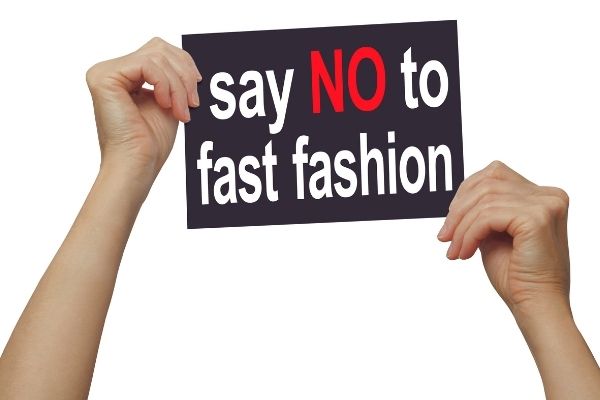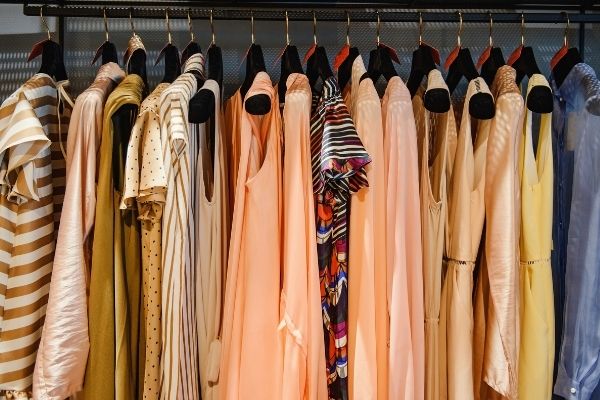There has been a major shift in the fashion industry. No, we are not talking about some change in a fashion trend. We are talking about fast fashion! In today’s world of consumerism, the rate at which we consume clothing is extremely high. Furthermore, fashion consumption is expected to grow; according to Green Peace, sales of clothing are projected to rise to $2.1 trillion by 2025. That’s a lot of demand!
To satisfy this ever-growing demand, fashion brands quickly overstock stores. Later, they toss their collections away to make room for the next micro-seasonal trend. These brands introduce new collections that imitate runway styles as often as several times per week.
Read on to know more about what is fast fashion, why it is bad, and what we can do about it.
What is Fast Fashion?
According to WTVOX, “Fast fashion is a term used to describe a highly profitable business model based on replicating catwalk trends and high-fashion designs and mass-producing them at low cost.”
So basically, retailers produce readily disposable, cheap clothes to keep up with faster trend cycles. These items aren’t designed with quality, longevity, or classic style in mind. Instead, they are made to be bought cheaply, worn a couple of times, and replaced quickly.
That is what fast fashion is all about!

Why is Fast Fashion bad?
This acute business model that tries to satisfy the consumers’ unquenchable thirst for fashion has extremely negative impacts on people and the environment.
- Every second a truck load of clothes is burnt or buried in landfill
- The fashion industry is responsible for 20% of global waste water
- Fast Fashion produces twice the amount of clothes today it did in 2000
- 1.2 billion tonnes of carbon emissions are released by the fashion industry every year
- The fashion industry is responsible for 2-8 of annual global carbon emissions.
Below are some reasons why fast fashion is bad and the problems that come with it.
Poor work conditions and unfair wages for workers
While the U.S consumes most of the world’s clothing, 90 percent of the world’s clothing is produced in developing countries. The workers making these clothes are paid less than a living wage, violating human rights in the name of fast fashion. In fact, 93% of brands surveyed by the Fashion Checker aren’t paying garment workers a living wage.
Along with low compensation, workers have to work in life-threatening conditions to produce these clothes. Due to this, workplace accidents are a major concern. The catastrophic collapse of the Rana Plaza factory in Bangladesh where 1134 garment industry workers were killed and wounded is a terrible example of what can happen. This accident was an eye-opener for fast fashion businesses and people worldwide.
There are many other issues with these workplaces like poor airflow causing workers to constantly breathe in dust and fiber from the textiles leading to problems like lung disease, cancer, and reproductive issues.
Pollution and extensive production of wastewater
Various activities like pumping water to irrigate crops, harvesting machinery, transportation, and oil-based pesticides used for the production of fibers all impact the environment.
Excessive use of water can cause drought, shortage of supplies, land clearance as well as soil damage. The findings from McKinsey’s latest report, The State of Fashion 2021, point out that solvents and dyes used in manufacturing are responsible for one-fifth of industrial water pollution. These chemicals combined with water often end up in rivers, streams, and oceans of the world.
Not to mention overall Fast fashion contributes 8% of the world’s carbon emissions.
High amounts of landfill waste
The reason why fast fashion is also called disposable fashion is the significant amount of waste it generates. Nowadays, we wear our clothes for shorter periods of time since we’re urged to update our wardrobes regularly to keep up with ever-changing trends.
Each year, an American throws away 70 pounds of clothing and textile on average. The disposal results in huge amounts of waste. These clothes are either burned or sent to a landfill. The truth is 85% of clothes that are produced end up in a landfill. We have become used to disposable fashion and fast fashion is a major cause of it.
How did we end up here?
You must be thinking, how did fashion speed up to its accelerated state today? In previous years, you used to go shopping for clothes a couple of times a year, replacing your wardrobe items according to the change in seasons, or because they were worn out or no longer fit you. You were even willing to purchase clothes from major fashion labels for the brand name and guaranteed quality.
Later, people started wanting clothing based on the latest fashion trends. The CEOs of fashion retail companies saw an opportunity in the consumers’ eagerness to purchase duplicates of these trends at a more affordable standard. That’s when they came up with the fast-fashion business model to meet the customer’s desires. Consumers accepted the low quality of the garments in exchange for lower prices. They were quick to toss away these items and move on to the next trend.
How can you reduce your impact and make a difference?
Our current global fashion industry is largely built around fast fashion. We understand it can be difficult to avoid it entirely, but you can still minimize your impact by making ethical fashion choices.
Here are some ways that you can do so:
- Shop your Wardrobe: This means re-wearing clothes you already own. Do your best to repurpose the items in your current wardrobe. You must have come across many Youtube or Instagram videos that provide you with tips on wearing the same clothing item differently. Try using such tips to get maximum wear out of your clothes without looking out of fashion. Work hard to keep them out of landfills. The damage has already been done, but you can only minimize future damage by being more responsible.
- Buy Secondhand: This is the next best way to fight fast fashion. We are already aware of the huge waste issue when it comes to our clothes. Buying secondhand clothing is a great way to reduce this waste (even if it was made in an unsustainable way). This will keep secondhand clothes out of landfills. You will find some amazing secondhand clothes at a lower price. It will, in turn, reduce the incentive that retailers make.
- Support Sustainable Clothing Brands: Sustainable clothing brands can sometimes be more expensive than the cheap fast fashion brands out there, but remember that you are paying for the quality. So rather than buying more low-quality clothes for less, opt for well-made, high-quality, sustainable clothes that will last you several years to come. Many of these brands can be shopped online at ease. Start becoming more conscious of your purchases.
- Follow the 30-Wears rule: A term coined by Livia Firth, founder of Eco-Age, the 30-Wears rule will help you make better purchase decisions. Before you buy an article of clothing, ask yourself, “Will I wear this at least thirty times?” If the answer is Yes, go ahead and buy it. If the answer is No, don’t buy it! Buying clothes that you will wear only once or twice is a waste of money, and the clothes will most probably end up in the trash.
- Shop Vintage: Vintage clothing has become a huge trend lately. By buying pre-owned vintage clothing, you will not only be celebrating past fashions but also keep up with the cyclic trends. Another great benefit of vintage clothing is the price! Some Instagram vintage shops are leading the way so that you can sort out some great vintage treasures from them. You might even find a brick-and-mortar vintage store in your area. Don’t compromise on principles, and don’t compromise on style!
- Embrace a minimalist way of life: A great place to start with implementing a minimalist way of life is with your closet. Not only can it help you save space, time, and money but it can help you embrace sustainable practices and reduce your impact on the planet. Read more about the benefits of a minimalist wardrobe and get some great tips in Minimalist Closet: Practice Minimalism with Your Wardrobe.
- Recycle your clothes: There are many options for recycling the clothes you no longer need. You can find out more in our article on Clothes Recycling: How to Recycle Clothes Sustainably.

The Wrap
As long as there is high demand, fast fashion will continue as a business model in the future. In time, if we make environmentally and ethically fair fashion choices, these brands will be forced to rethink how they operate. We are already seeing some wider shifts emerging against the wave of fast fashion. A lot of people have started questioning and challenging rampant consumerism.
We need individual consumers like you to start making more conscious choices and avoid fast-fashion retailers and brands. Even though you’re surrounded by this fast-paced industry, you can make a considerable difference if you slow down and make mindful purchases. Becoming a conscious consumer is a journey.
Even if you mistakenly fall off the ethical track, get back up again. Don’t quit! Your every ethical purchase decision has a positive impact.
Sources
- Greenpeace International, 2017, Fashion at the Crossroads
- Katherine Saxon, 2020, This Is What Fast Fashion Really Means (Definition, Problems, Examples)
- Rachel Bick, Erika Halsey & Christine C. Ekenga, 2018, The global environmental injustice of fast fashion
- Fashion Checker, Are the People Who Make Your Clothes Paid enough to live on?
- 1996-2021 International Labour Organization (ILO), The Rana Plaza Accident and its aftermath
- Shari Nijman, 2019, UN Alliance For Sustainable Fashion addresses damage of ‘fast fashion’
- Lydia Mcallister, 2016, Textile waste by the numbers
- Morgan McFall-Johnsen, 2019, The fashion industry emits more carbon than international flights and maritime shipping combined. Here are the biggest ways it impacts the planet.
- McKinsey, 2020, The State of Fashion 2021: In search of promise in perilous times
- Fashion United: Global Fashion Industry Statistics














